Does Home Staging Really Work? What Sellers Should Know

For more than 20 years, the benefits of home staging have been well documented. Countless studies have shown that staging helps homes sell more quickly, and often for a higher price. According to the National Association of REALTORS®, 30 percent of agents reported that staging led to a 1 to 10 percent increase in the dollar value offered by buyers, and nearly half of sellers’ agents said staging helped reduce the time on market. Studies also indicate that buyers can generally decide if they’re interested within the first 30 seconds of seeing a home.
Staging is all about creating a welcoming, move-in-ready atmosphere. It helps buyers picture themselves in the space, highlights your home’s best features, and minimizes anything that might distract from its potential. From small styling updates to full furniture placement, staging can make a big difference in how your home is perceived and how it performs on the market.
If you’re planning to sell, here’s why staging is still one of the smartest strategies you can use and how to make the most of it.
A Strong First Impression Starts Online
In 2023, the National Association of REALTORS® Generational Trends Report revealed that 96 percent of buyers now rely on the internet to search for their next home. And in a market where most buyers begin their home search online, how your home looks and feels from the start has never been more important. Your online photos, videos, and virtual tours should make buyers want to see more. Staging helps make that possible by photographing better, helping rooms look more spacious and inviting, and encouraging buyers to take the next step.
Thanks to newer tools like virtual staging and AI design platforms, sellers have more options than ever to enhance their home’s online presence. These can be especially helpful for vacant homes or spaces that are difficult to define, giving buyers a sense of scale, purpose, and warmth before setting foot in the front door.
What Rooms Matter Most?
Not every room in your home needs to be staged, but some have more influence on buyers than others. 37 percent of buyer’s agents say that the living room is the most important room to stage, followed by the primary bedroom at 34 percent, and the kitchen at 23 percent. These are the spaces where people imagine themselves spending the most time, relaxing, hosting, and settling into daily life.
Staging can also be especially helpful in vacant rooms or uniquely shaped rooms. A few well-placed pieces of furniture can help define how the space might be used and create a natural flow from room to room. When these rooms feel welcoming and well put together, buyers are more likely to see the home as a fit for their lifestyle. A little extra effort in the right spaces can go a long way toward making that connection.
Clear, Clean, and Clutter-Free
To further inspire buyers to imagine the space as their own, make sure every room—including closets and the garage—is clean and clutter-free. You may even want to hire professionals to give your home a thorough deep clean.
Family photos, personal memorabilia, and collectibles should be removed from the home for your safety. Closets, shelves, and other storage areas should be mostly empty. Workbenches should be free of tools and projects. Clear the kitchen counters, store non-necessary cookware, and remove magnets from the refrigerator door.
The same goes for furniture. If removing a chair, a lamp, a table, or other furnishings will make a particular space look larger or more inviting, then do it.
You don’t want your home to appear cold, unloved, or unlived-in, but you do want to remove distractions and provide prospective buyers with a blank canvas of sorts. Plus, de-cluttering your home now will make it that much easier to pack when it comes time to move.
Every home is a personal expression of its owner. But when you become a seller, you’ll want to look for ways to make your home appeal to your target market. Keep in mind, your target market is the group of people most likely to be interested in a home like yours, which your agent can help you determine.
A good strategy for staging your home is to “neutralize” the design of your interior. A truly neutral interior design allows people to easily imagine their own belongings in the space—and to envision how some simple changes would make it uniquely their own.
Paint over bold wall colors with something more neutral, like a light beige, warm gray, or soft brown. The old advice used to be, “paint everything white,” but often that creates too sterile an environment, while dark colors can make a room look small, even a bit dirty. Muted tones and soft colors work best. Likewise, consider removing wallpaper if it’s a bold or busy design.
Lighting is key. Replace heavy, dark curtains with neutral-colored sheer versions; this will soften the hard edges around windows while letting in lots of natural light. Turn on lamps, and if necessary, install lighting fixtures to brighten any dark spaces—especially the entry area.
A Smart Investment with Lasting Impact
Staging is a powerful advantage when selling your home, but that’s not the only reason to do it. Staging uncovers problems that need to be addressed, repairs that need to be made, and upgrades that should be undertaken. Staged properties are more inviting, and that inspires the kind of peace of mind that gets buyers to sign on the dotted line. In the age of social media, a well-staged home is a home that stands out, gets shared, and sticks in people’s minds.
What’s more, the investment in staging can bring a higher price. According to the National Association of REALTORS®, the average staging investment is between 1 percent and 3 percent of the home’s asking price, and typically generates a return of 8 to 10 percent.
In short, with less time on the market and higher selling prices, the small cost of staging your home is a wise investment.
Where to Start
If you’re concerned about the additional cost of staging, rest assured. Even a relatively small investment of time and money can reap big returns. There are even things you can do yourself for little to no cost. Contact your agent for advice on how to stage your home most effectively or for a recommendation on a professional stager. While the simple interior design techniques outlined above may seem more like common sense than marketing magic, you’d be surprised at how many homeowners routinely overlook them. And the results are clear: staging your house to make it more appealing to buyers is often all it takes to speed the sale and boost the sale price.
Local Look Western Washington Housing Update 11/6/25

Hi. I’m Jeff Tucker, principal economist at Windermere Real Estate, and this is a Local Look at the October 2025 data from the Northwest MLS.
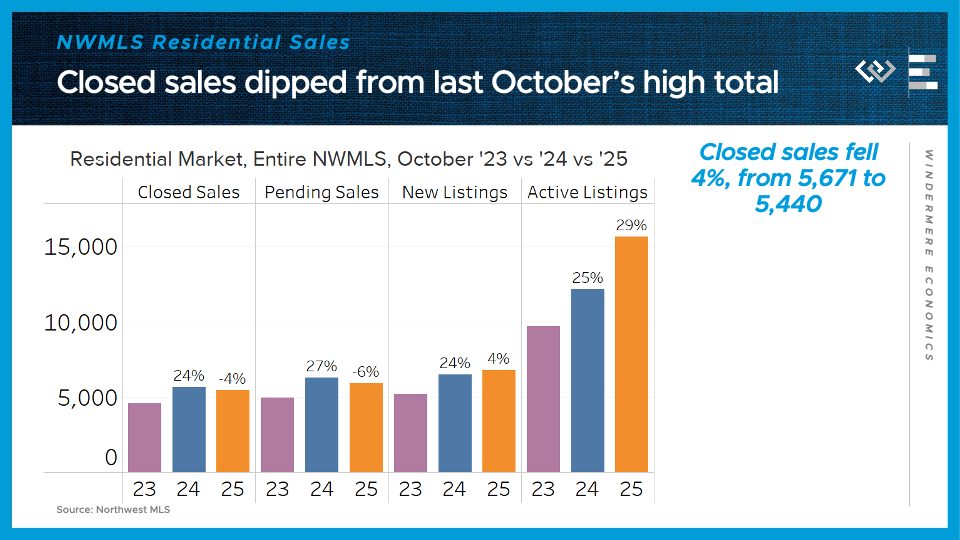
This October, the Washington housing market began its usual seasonal shift into the cooler 4th quarter. Compared to last year, it looked particularly cool, because last October saw a sudden burst of buying activity in the wake of the Fed finally beginning to cut interest rates.
Across the Northwest MLS, closed home sales came in 4% below last October’s total. MLS. Pending sales, which give some signal about next month’s sales, were down 6% from the same time last year.
On the supply side, the flow of new listings remains roughly even with last year’s, or just 4% higher. Finally, the month ended with 29% more active listings than last October, continuing a slowdown in inventory growth but still leaving buyers with more options than they had last year or the year before.

Those higher inventory levels are starting to put some downward pressure on prices, which dipped 2%, to a median of $660,000 for a residential home sale in October.
Now I’ll turn to a closer look at the four counties encompassing the greater Seattle area.
Now I’ll take a closer look at the four counties encompassing the greater Seattle area.
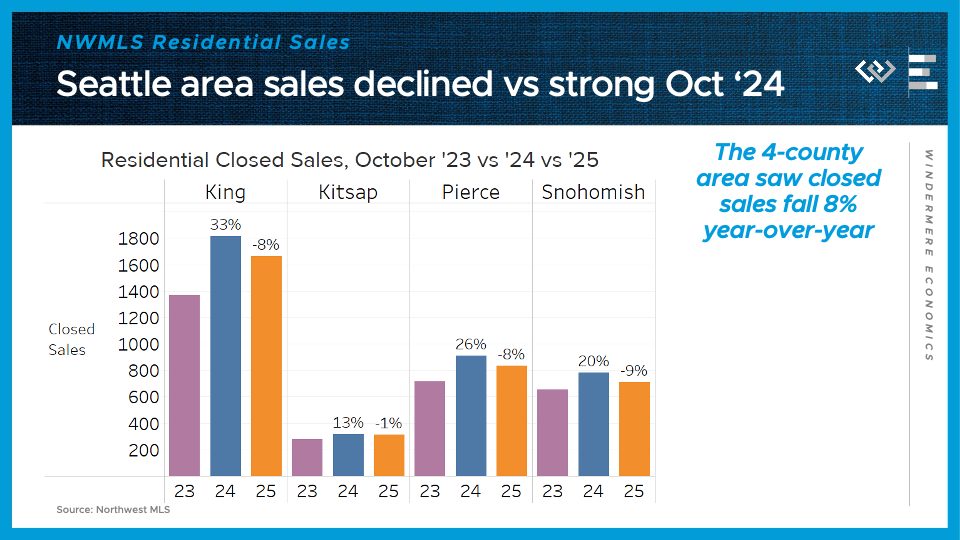
Closed sales stepped down by 8% from last October, although that month last year had unusually high sales, especially in King County, where 2024’s sales were a whopping 33% higher than in 2023.
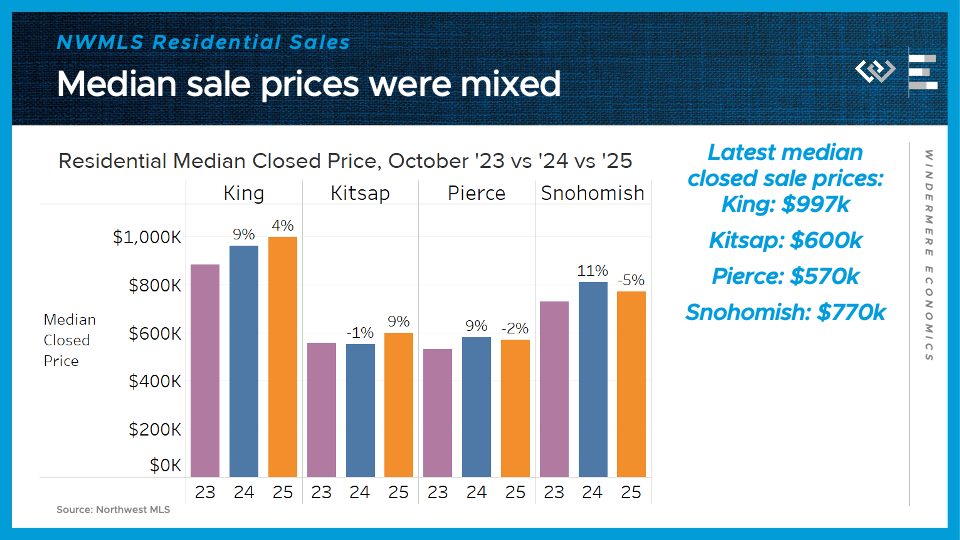
Median sale prices were split: 4% higher in King; 9% higher in Kitsap; but 2% lower in Pierce, and 5% lower in Snohomish County. That may represent a continued trend of demand retrenching toward the employment center of the region, around Seattle and Bellevue, as new return-to-office policies come into effect.
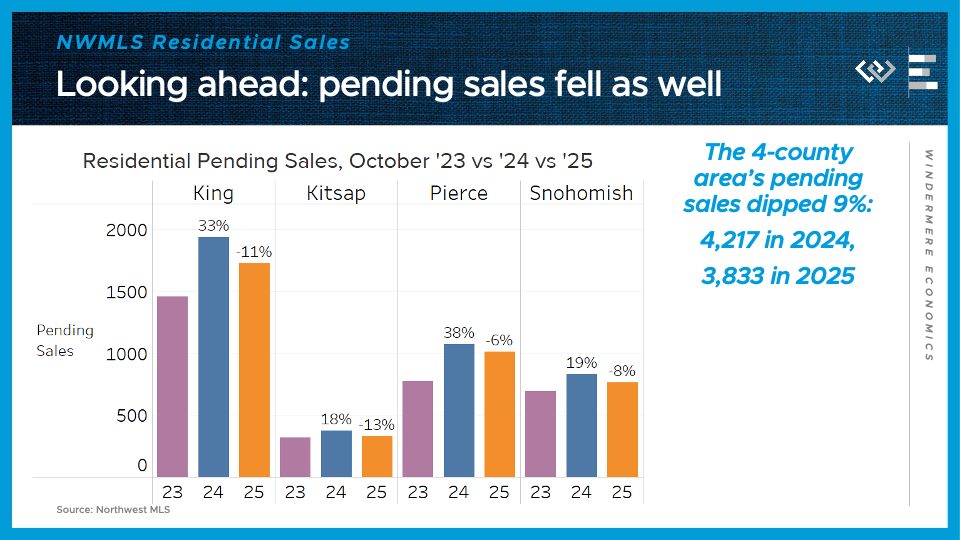
Looking ahead, pending sales fell 9% across the region, although again King County’s sales drop looks a bit like mean reversion after a standout 2024 number.

On the supply side, the 4-county greater Seattle area had 31% more active listings than at the end of October 2024. That continues the moderation of inventory growth we’ve seen since May, when this metric peaked at 45% year-over-year growth.
Looking ahead, we are entering one of the best times of the year for savvy buyers and their agents to find a bargain, and with much more inventory than even this time in the last two years. Whether they jump at the opportunity will be revealed in next month’s data!
Numbers to Know 10/22/25: The Latest on Jobs, Housing & Mortgage Rates

This is the latest in a series of videos with Windermere Principal Economist Jeff Tucker, where he delivers the key economic numbers to follow to keep you well-informed about what’s going on in the real estate market.
The government has shut down, and that means most government data publication has paused as well. The monthly CPI inflation report is delayed, and the monthly jobs report is suspended this month. So I’ll have to plan to revisit those when they resume, and in the meantime, I’ll start by checking in on the last publication out of the BLS before the shutdown: the Job Openings and Labor Turnover Survey, or JOLTS for short.
3.2%
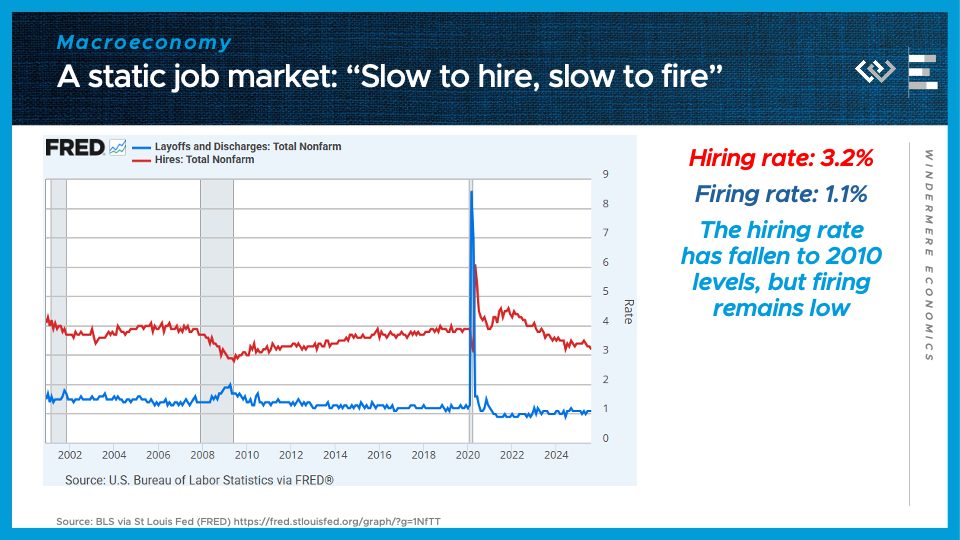
That was the hiring rate in August, meaning the share of the workforce that just got hired. It’s around the lowest hiring rate since 2010, when the economy was just beginning to dust itself off and climb out of the Great Recession. It’s one half of a simple summary of the economy that labor economists have been using for a couple years now: “Slow to hire, slow to fire.”
1.1%
That’s the rate of layoffs and discharges, or, broadly, the firing rate, to fit the rhyming scheme. It is not particularly high right now, even if it’s up slightly from the essentially record-low firing rate below 1% we saw briefly in 2022.
Putting it together, what “Slow to hire, slow to fire” means is that employers are essentially hunkering down, hanging on to their workers but not interested in growing those payrolls quickly. For people with jobs, this means the economy feels essentially OK – not great, but OK. But for those without a job, it’s proving unusually hard to break back into the workforce, which makes this a terrible time to be unemployed, and is gradually inflicting stress on the credit system and consumer spending. These are early signs of an economic slowdown, but not yet any indication of a recession.
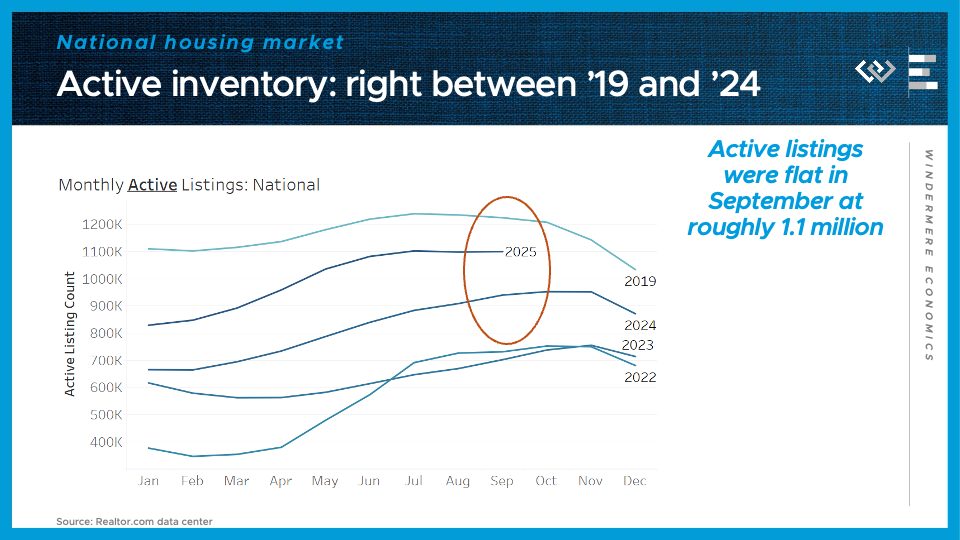
Turning to the housing market: we’ve got a familiar refrain this month. More inventory means buyers have gained more negotiating leverage, although September likely represented the high-water mark for the year, with about 1.1 million active listings for the 3rd month in a row. That’s 17% more than the same time last year.
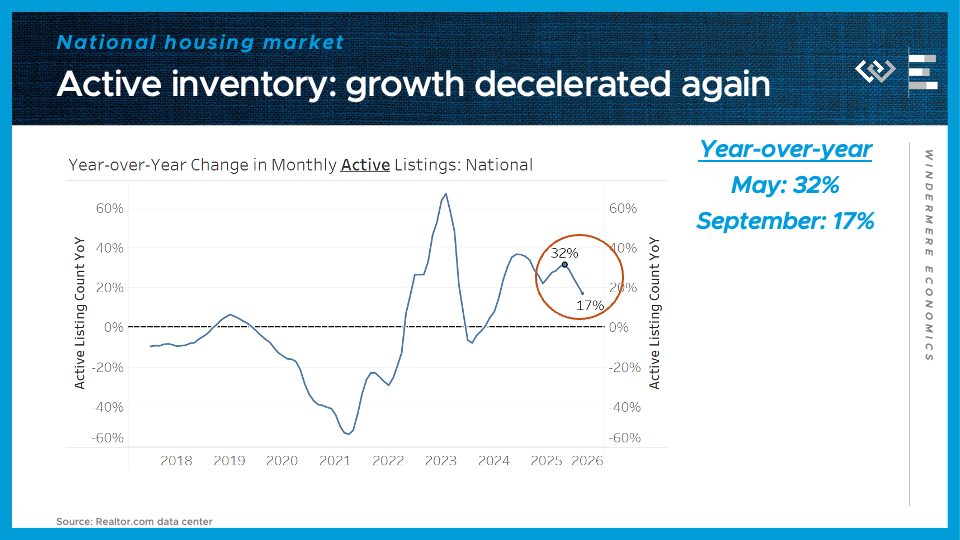
Importantly, inventory growth has passed an inflection point: for the fourth month in a row, the pace of growth of inventory has fallen yet again. Growth has now been roughly cut in half, from the 32% annual growth seen in May. That means inventory is not on a runaway growth track toward a glut that would push prices down. Rather, the market is re-equilibrating, as some sellers steer clear of a buyers’ market, or de-list after not getting a satisfactory offer. For buyers, it means conditions have moved in their favor but they shouldn’t count on that trend intensifying much further.
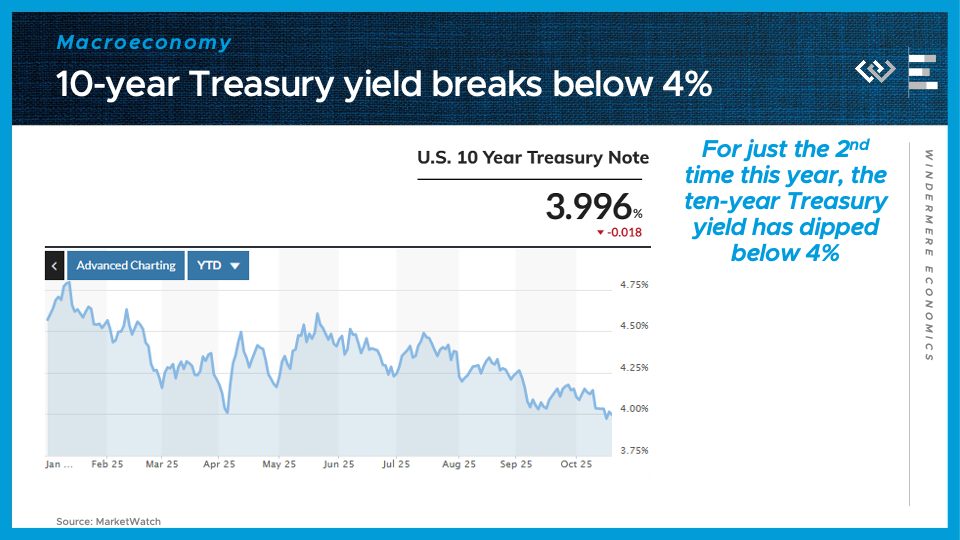
Another helpful factor for buyers, though, is that borrowing costs have continued to fall. The ten-year treasury yield, which is a major benchmark that mortgage rates tend to track, plus about 2 points, has now dipped below 4% for the first time this year. That reflects the combination of lower expected economic growth, and the resulting lower Fed Funds Rates expected over the next few years, as the Fed reacts to try to prevent a recession.
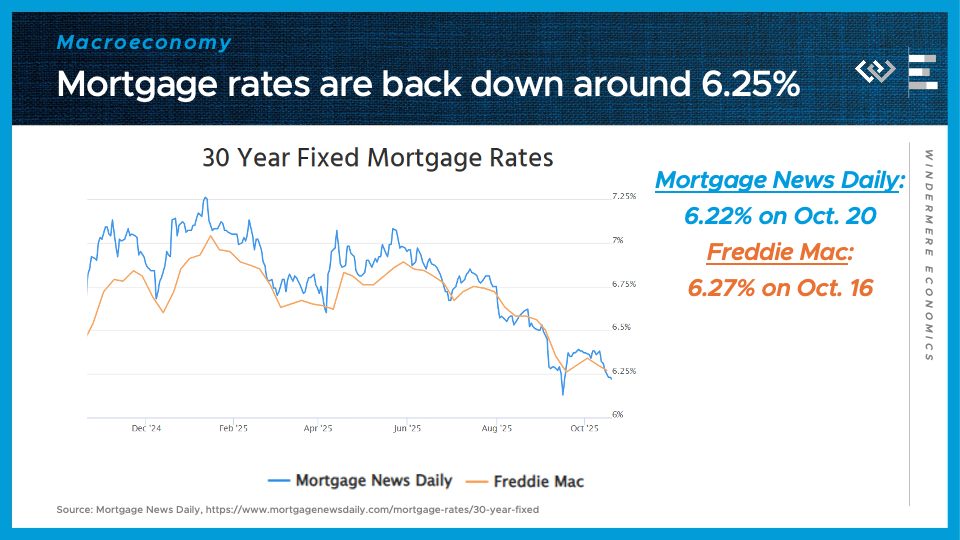
Hand in hand with those lower Treasury yields: Mortgage rates are moving back into their most favorable territory in 12 months, right around 6.25%. That represents significant savings compared to the rates of around 7% to start the year, and is partly driven by investor expectations of interest rate cuts to come. Because those expectations are already factored into the lower rates today, there’s no guarantee that mortgage rates will fall further even if and when the Fed continues cutting its overnight rate.
That is all for this month; I hope we’ll have more BLS data next month, and thanks as always for watching!
Housing Market Cools Alongside Economy in Third Quarter

This is the first in a recurring series of blog posts taking a closer look at the U.S. economy and several major regional markets in Windermere’s nine-state footprint*. Updates will be released on a quarterly basis.
*This Stephanie & Christine post specifically focuses on regions in Washington State.
See full post here
Economic Overview
After a slow spring, the U.S. housing market cooled further this summer, with price gains leveling off and sales holding steady. Existing home sales have hovered around an annualized pace of 4 million through August—nearly identical to last year’s unusually low 4.06 million. Mortgage rates dropped in the third quarter, falling from an average of 6.82% in May and June to 6.35% in September. The combination of rising inventory, softer pricing, and lower mortgage rates is making this fall a good time to buy a home.

Source: Freddie Mac via FRED.
A key driver behind falling mortgage rates is the cooling U.S. economy, following a sharp slowdown in job growth over the summer. After revisions, nonfarm payrolls show little to no growth from April through August, and the next jobs reports are on hold due to the government shutdown. While slower growth poses challenges, it often brings the silver lining of lower interest rates—and this cycle appears to be following that pattern.
The following is a detailed overview of recent housing trends across three regional markets within Windermere’s footprint during the third quarter of 2025. They include Greater Seattle Area, Northwest Washington State, and Spokane County.
To see overview of Greater Portland area & Greater Sacramento Area, see full post here.
Greater Seattle Area (King, Snohomish, Pierce, and Kitsap Counties)
High inventory in the greater Seattle area has swung the balance of negotiating power in buyers’ favor across the region this year. As of the end of September, buyers could choose from nearly 9,200 active listings—8% more than the same time in 2024. Still, inventory growth has slowed throughout Q3, from a peak of 48% year-over-year growth back in May. Slower inventory growth means we are not headed for a glut of listings, which is good news for sellers.
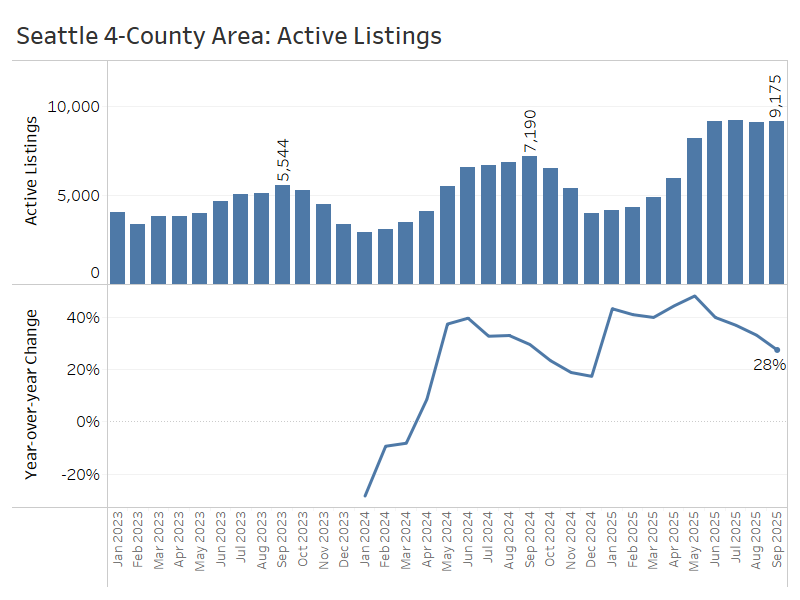
Inventory growth reflects several consecutive months of risingnew listings outpacing closed sales, which gradually replenishesthe supply of homes for sale. In September, the greater Seattle area had just over 5,300 new listings—about 12% more than last September. The entirety of Q3 reported 15,500 new listings, a 7% increase from Q3 2024.
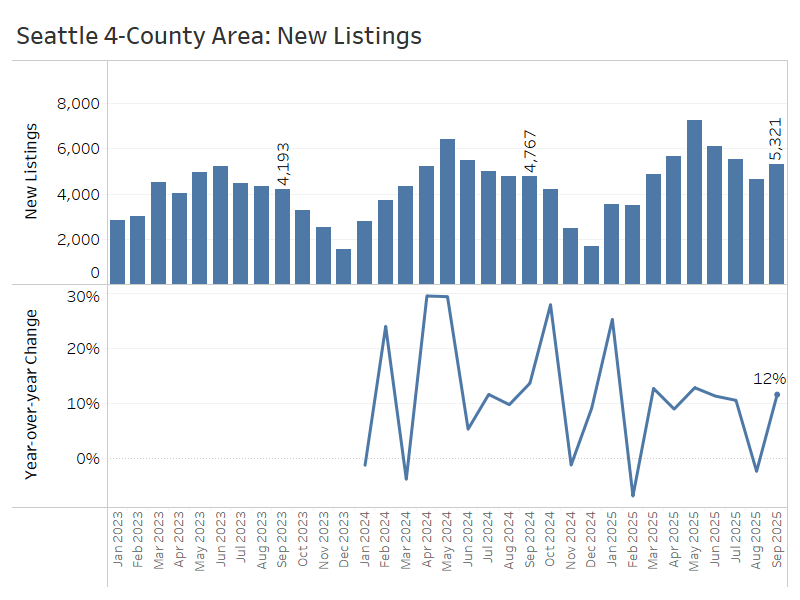
Not only do buyers have more options compared to a year ago, but they are also seeing listings linger on the market longer : an average of 36 days on market in September, up from 28 days last year. Days on market were substantially longer than last year’s levels in each month of Q3.
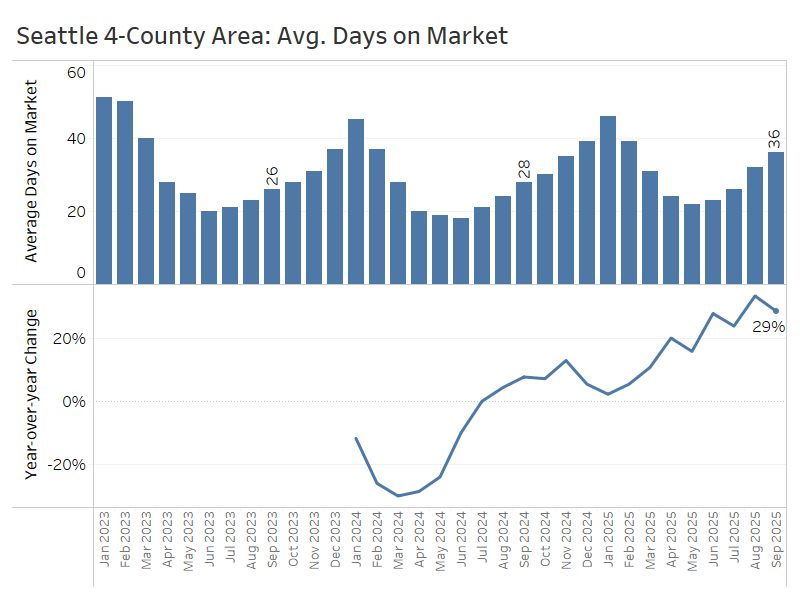
Unfortunately, the growth of inventory and new listings has not done much to generate home sales. Closed sales in Septembertotaled just under 3,500—virtually unchanged from the same period last year—following year-over-year declines of 3% in July and 4% in August.
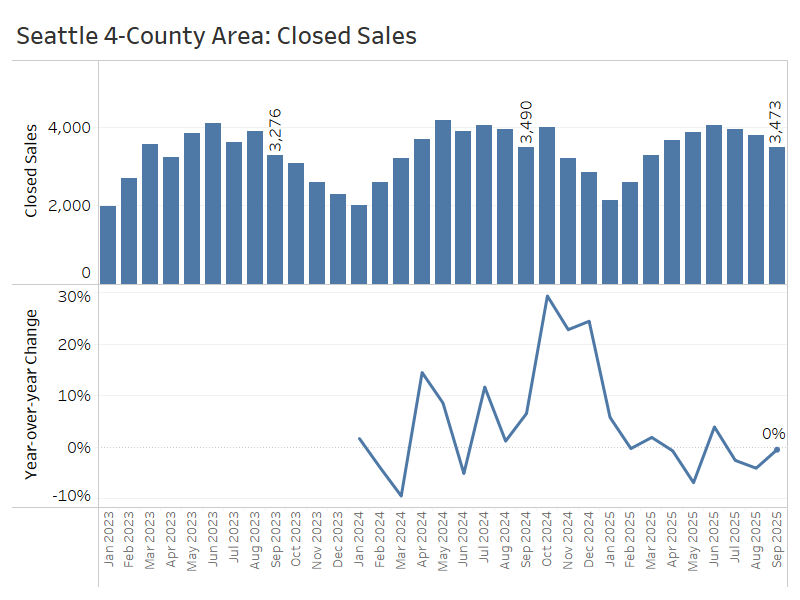
Home prices remain flat alongside sales. September’s median price of $750,000 was up less than 1% from a year ago, after slight declines in July and August. High mortgage rates and affordability challenges are capping price growth, while rising inventory will likely put downward pressure on prices going forward. The wildcard is seller behavior—whether they’ll cut prices to sell or hold firm and wait.
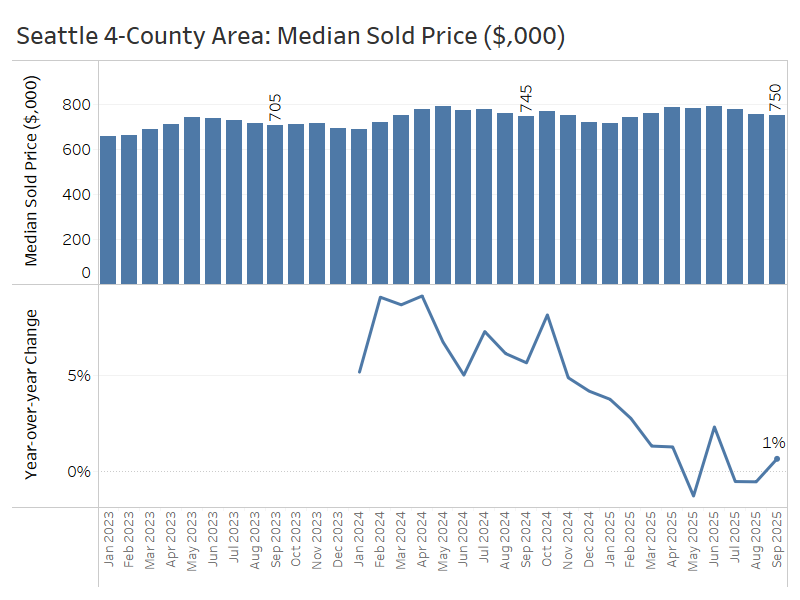
The greater Seattle region is still grappling with elevated inventory, but it has clearly passed an inflection point: inventory growth decelerated over the third quarter, preventing conditions from swinging much further in buyers’ favor. As it stands, they’llstill have ample options and negotiating leverage this fall and winter.
Northwest Washington – Skagit, Whatcom, San Juan, and Island Counties
North of the greater Seattle area, the market conditions in the four northernmost counties of the Puget Sound region are experiencing a major shift in buyers’ favor.
At the end of September, there were 1,900 active listings, up 35% from a year ago. There’s no evidence of a slowdown in inventory growth here, like that of the Seattle area this quarter.
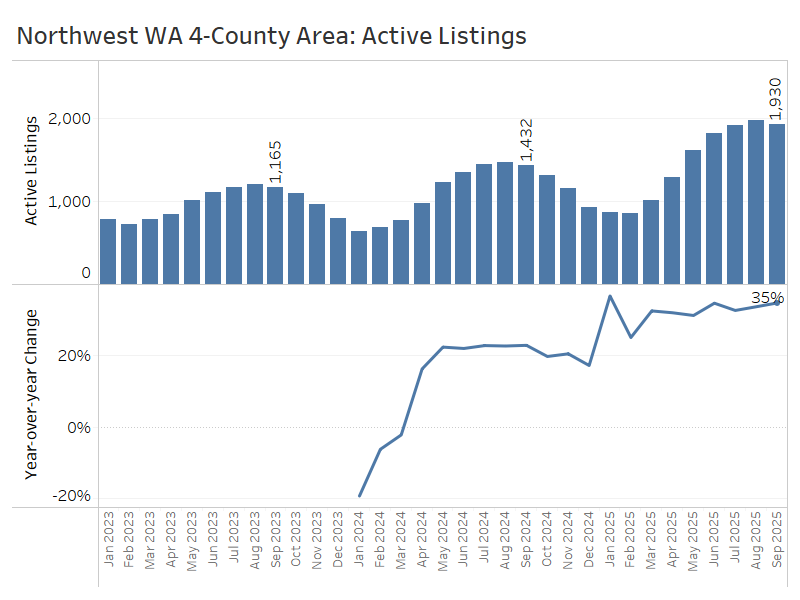
The flow of new listings has experienced healthy growth throughout most of 2025, resulting in a 21% increase compared to September of last year.
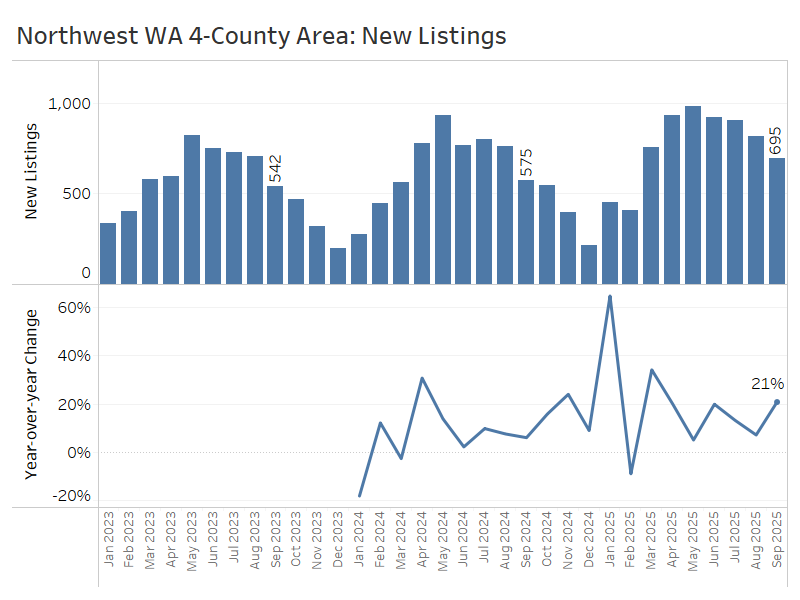
Time on market has climbed modestly but steadily all year, now up to 44 days on average in September, up from 41 days last year.
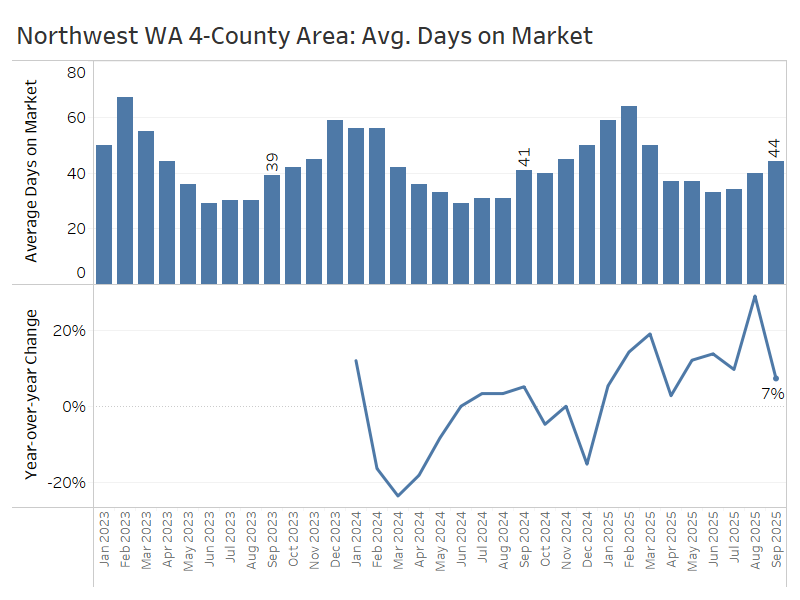
Closed sales were up 3% year over year in September, after a 3% dip in August and 10% growth in July.

Compared to the same time last year, median home prices rose 2% in July, dipped 6% in August, and then increased 1% in September to $625,000.
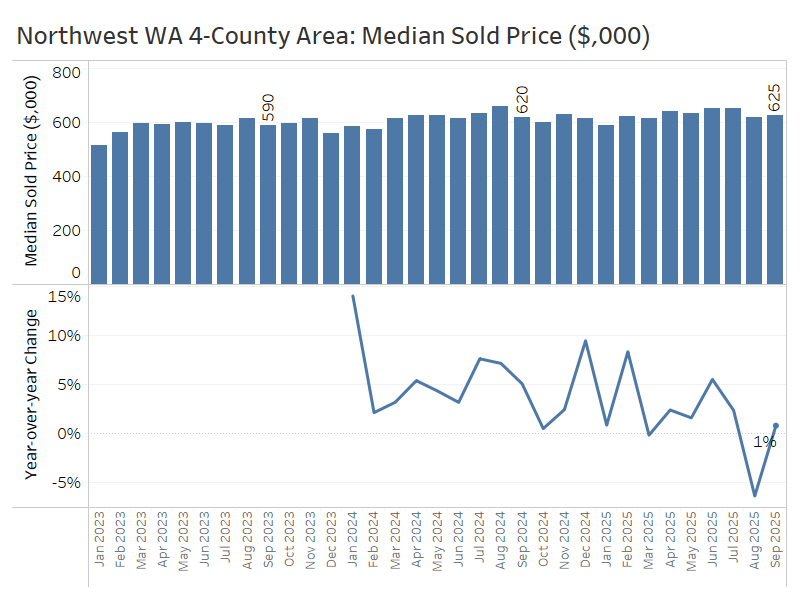
Looking ahead, prices will likely cool as buyers take advantage of increased inventory and gain more negotiating power.
Spokane County, Washington
Spokane County, which anchors Eastern Washington, is experiencing many of the same market trends as Western Washington: higher inventory, softer buyer demand, and flat home prices.
At the end of September, there were just over 2,000 active listings, up 32% from a year ago and significantly higher than two years ago, when there were fewer than 1,300 listings. The pace of inventory growth has only slightly slowed from the 33% year-over-year increases we saw in July and August.
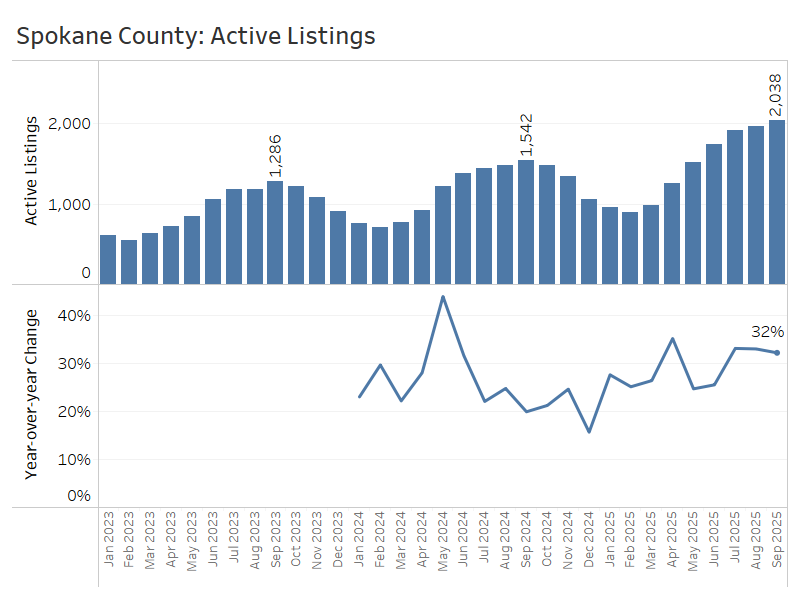
New listings climbed 11% from last September, after increasing 26% in July and 5% in August.

Unlike some of the other markets in this report, Spokane has seen only modest increases in the number of days it takes to sell a home, averaging 33 days this September, up from 32 during the same time last year.
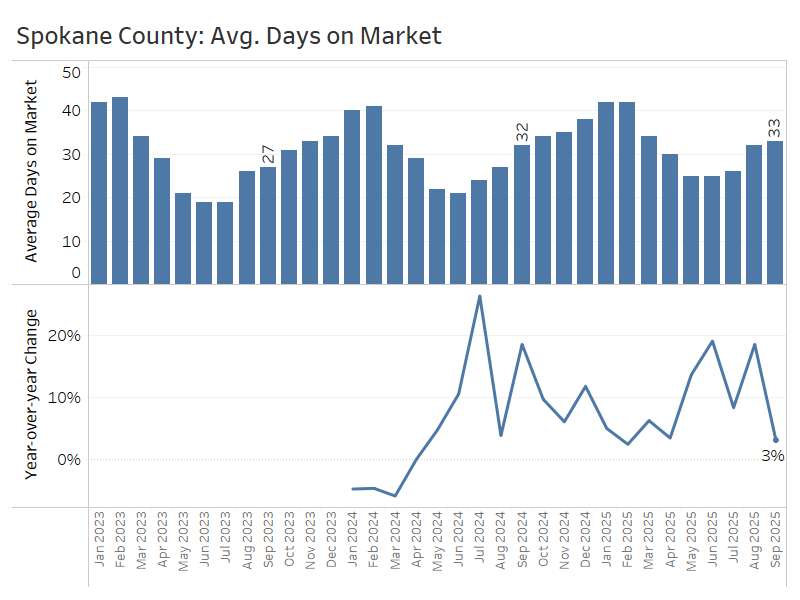
Closed sales in September were up 5% year over year, following a 3% increase in August and relatively flat sales in July.

Compared to last year, median sale prices in September dipped by about 1%, from $439,000 to $433,000. Prices were relatively flat year over year in July and August.
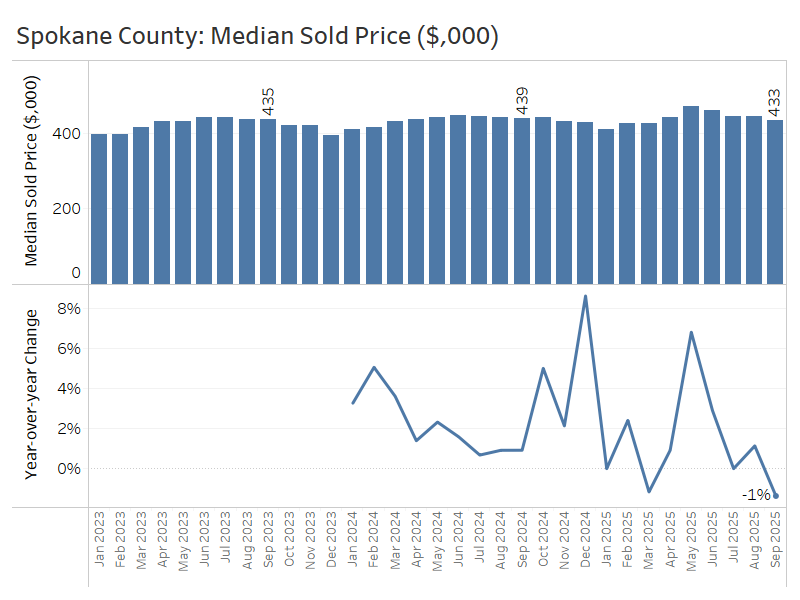
Altogether, the more balanced market conditions in Spokane this summer began to yield more sales activity alongside flat to slightly lower prices— a healthy combination for the market right now.
Conclusion
All of the markets covered in this report have shifted into balanced or buyer-friendly territory, so it’s a good time to plan accordingly.
A consistent theme across the regions is the rise in inventory, paired with flat home sales and relatively flat prices compared to a year ago. This environment offers prospective buyers several advantages: more homes to choose from, greater leverage to negotiate, and less pressure to rush into a decision or compete in bidding wars.
For sellers, it’s important to be aware that the market has changed. Unlike the last several years, buyers now have more options, and home prices have leveled off. Success in today’s market depends on setting a realistic list price and presenting the home in its best possible light. With the right strategy, many homes are still selling quickly—and even above asking price—in every market highlighted in this report.
Sources: TrendGraphix analysis of NWMLS, RMLS, Spokane MLS, MetroList MLS, and Wasatch Front MLS data.
As Principal Economist for Windermere Real Estate, Jeff Tucker is responsible for analyzing and interpreting economic data and its impact on the real estate market on both a local and national level. Jeff has over 10 years of experience as an economist at companies such as Zillow, Amazon, and AirDNA.

Issaquah is ripe with great eats, drinks, and people.
We’ve compiled a list of Issaquah’s highest rated restaurants & coffee shops, by category, just for you. So if you’re looking to expand your palette, check them out & let us know what you think!
Eats:
Breakfast/Brunch
Donuts
Sandwiches
Seafood
Asian
Steakhouse
Drinks:
Coffee
Bubble Tea
Tea
Bars
📍317 NW Gilman Blvd #31-B, Issaquah
⭐️⭐️⭐️⭐️, (912 Reviews)
(Ratings Attributed to Yelp & OpenTable)

Corner Lot, Easy Commute, Top-Rated Schools:
Need We Say More?
4514 186th Ave SE, Issaquah

4 BED | 2.5 BATH | 2,085 SQFT
OFFERED AT $1,300,000
Spacious, fully fenced corner lot along a flat cul-de-sac in a highly rated school district.
Lovely, classic two-story home with an easy commute on I-90. Just minutes to Factoria or Downtown Issaquah, and a quick jaunt or easy bike ride to community parks and beach access. Truly the perfect location!
Spacious backyard with large, railed deck, stone patio, and two separate lawn areas make the perfect space for simultaneous pets, play, and hosting. What more could you want?
Inside, find warm hardwoods and fresh carpet+paint throughout. 4 bedrooms upstairs with formal living, dining, and family rooms down means space for all.
3x mini split in addition to whole house forced air and A/C, plus a gas fireplace makes for easy comfort, year-round.
Don’t pass this one up!

Multipurpose Backyard
Fully fenced yard with separated areas make a great layout for tons of activities! Let out the dog in the side yard, have the kids play in the back, and eat dinner on the deck or patio, undisturbed.
Neighborhood Bliss
Easy access, anywhere. Get to the freeway in 2-3 minutes and pop over to Factoria or Issaquah in 10. So convenient! Not to mention the walkability. Flat neighborhood with nearby parks, trails, and beach access are a huge plus. You can have it all!



November Events 2025
Arts & Culture
Sports
Day of the Dead Events
NOV 1 - 8 | Seattle/Tacoma | Details
Seattle Restaturant Week
NOV 1 - 8 | Seattle/Eastside | Details
Shucked (Musical Comedy)
NOV 4 - 9 | Paramount Theatre | Details
Astra Lumina
NOV 6 - DEC 31 | Seattle Chinese Garden | Details
Snohomish Brewfest
NOV 8 | Thomas Family Farm | Details
Queen Anne Fall Wine Walk
NOV 8 | Details
Veterans Day Events
NOV 9 - 11 | Multiple Locations | Details
Free State & National Parks Day
NOV 11 | All State & National Parks
Quilt, Craft, & Sewing Festival
NOV 13 - 15 | Puyallup | Details
DB Cooper Conference
NOV 14 - 16 | Vancouver, WA | Details
Seattle International Auto Show
NOV 14 - 16 | Lumen Field | Details
WildLanterns
NOV 14 - JAN 18 | Woodland Park Zoo | Details
Seattle Christmas Market
NOV 20 - DEC 24 | Seattle Center | Details
Renegade Craft Fair
NOV 22 - 23 | Magnuson Park | Details
Our Annual Thanksgiving Pie Giveaway Event
NOV 25 | Our Bellevue Office | Details to Come
GeekCraft Expo / Holiday Market
NOV 28 - 30 | Magnuson Park | Details
Magic in the Market
NOV 29 | Pike Place | Details
Kraken Hockey
NOV 1 - APR 13 | Climate Pledge Arena | Details
Huskies Men's Basketball
NOV 3 - MAR 4 | Alaska Airlines Arena | Details
Newport Ski Swap
NOV 8 - 9 | Newport High School | Details
Puyallup Flat Track Motorcycle Racing
NOV 8, 22 | WA State Fair Events Center | Details
Seahawks Football
NOV 9 - DEC 18 | Lumen Field | Details
Huskies Football
NOV 15 - DEC 29 | Husky Stadium | Details
Turkey Trot(s)
NOV 16 - 27 | Multiple Locations | Details
Endurocross: Extreme Dirt Bike Racing
NOV 22 | Everett | Details

Dear Friends,
You may already know that Stephanie, her husband Erik, and their daughter Mary have recently lost their son and brother, Thomas, to suicide after a long battle with his mental health.
Stephanie will be stepping back from a front-facing role in our real estate practice for the time being. Please direct any business to SCTeam@windermere.com, or to Christine’s cell, 425-417-6892.
Thank you to everyone who has already voiced their support. It means a lot that so many people want to reach out. We ask that in lieu of social visits, texts, calls, or flowers, you may support the Kristen family through any of the following means:
- Donate in Tom’s memory to Youth Eastside Services, a Bellevue-based organization that provides services for youths suffering with mental health disorders and other life stressors. (Directions below!)
- Mail or drop off a card to our Bellevue Office, 14405 SE 36TH ST #100, and we'll make sure it gets to them
- Volunteer to provide a meal for the Kristen family through Meal Train. Contact scteam@windermere.com or reach out to Christine for the link.
We appreciate your support and grace through this difficult time. Please keep the Kristens in your thoughts and prayers, and hug your loved ones tightly.

Youth Eastside Services Donation Instructions:
Here is the link to donate:
https://wl.donorperfect.net/weblink/WebLink.aspx?name=yes&id=64
- Underneath the donation amount, click the checkbox titled “I would like to dedicate my donation in honor or in memory of someone”
- This will pop up a couple more prompts.
. - One is a dropdown box titled “Type of Tribute”,
- Select “In Memory of” as the type of tribute
. - The next one is a field called “Tribute Name”,
- Type in ‘Thomas Kristen’
. - Below is a section titled “Send Notification to:”,
- You may type ‘Stephanie Kristen’ in the Name prompt
- Leave the Address prompt empty
- In the Email prompt, type in scteam@windermere.com, so that we’ll receive a notification that you’ve donated in Tom’s name.
(It will not tell us the donation amount).
. - Then fill out the rest of the form with your own contact information and card information.
.
If you’re having trouble, please don’t hesitate to reach out.

From Starter Home to Forever Home
4285 167th Court SE, Bellevue WA

6 BED | 4 BATH | 4,380 SQFT
Nothing beats a starter home like a forever home, and we’re especially honored to have been able to find both for these clients! 🤗
A few years back, we helped them purchase their starter home in Issaquah, and now we’ve just helped them close on their forever home in Bellevue. What a pleasure!
We’re extra proud of this one, as we got it under contract in under 24 hours from the list time! These clients had been searching for a while, and they knew exactly what they were looking for. So when this home came on the market, we jumped right away!
🎉 Our clients are thrilled, and so are we! We love what we do, and it’s so rewarding to help our clients transition to the next step in their home ownership journey. Buying, selling, or just planning what’s next, we’re here to make it as easy as possible for you!

Why AI Can’t Replace Your Real Estate Agent

Technology is transforming nearly every industry, and real estate is no exception. New tools and innovations are reshaping the way we search for, buy, and sell homes. Among these advances, artificial intelligence (AI) has quickly become one of the most talked-about technologies, being used for everything from writing and research to customer service. Naturally, this raises the question of whether it could ever replace jobs that rely on human connection and expertise, like real estate.
In the sections ahead, we’ll break down what AI can and can’t do in real estate, and how agents can use it to their advantage rather than view it as competition.
What is AI?
Artificial intelligence (AI) is technology that allows machines to simulate human intelligence. In recent years, AI has grown at lightning speed and has become part of daily life, often in ways people don’t even notice. Generative AI tools like ChatGPT, Copilot, Gemini, etc., are the ones most people hear about because they can answer questions, draft text, or create images. At the same time, other forms of AI are working quietly behind the scenes on websites, apps, and services we use daily, from recommendation engines to fraud detection.
Together, these tools are changing how we interact with technology, making it faster and more efficient. But when it comes to buying or selling a home, no algorithm can replace the insight, guidance, and personal care of a trusted real estate agent.
How AI is Shaping Real Estate
AI is already influencing how buyers and sellers approach the market. From predictive pricing tools and market analysis platforms to more intelligent home search engines, AI can process large amounts of data and provide insights more quickly than any individual could manage on their own. For agents, it can automate repetitive tasks like drafting emails or creating basic listing descriptions, while chatbots help answer simple client questions around the clock. Some platforms even use AI to match buyers with properties based on preferences or past behaviors. These tools save time and make processes more productive, but they’re only part of the real estate experience.
Why Real Estate Needs a Human Touch
The Future: Agents + AI, Not Agents vs. AI
Buying or selling a home is never just about the transaction—it’s often one of the biggest financial and emotional decisions of a person’s life. And while AI may provide quick data or market insights, it can’t sit down with an individual and understand their specific needs, calm their nerves during a stressful moment, or celebrate when the keys are finally handed over.
A real estate agent listens, adapts, and advocates for their clients in ways that no algorithm can replicate, bringing empathy, intuition, and lived experience into the equation rather than just facts and figures. They know the neighborhoods, the schools, and the subtle details that make a house a home. They can recognize when a client needs reassurance, when to negotiate a little harder, and when to suggest a creative solution to keep a deal moving forward. These instincts and skill sets are built on years of human connection, which is what makes the difference between simply completing a deal and guiding someone through a life-changing experience or helping them reach their real estate goals.
Rather than replacing real estate agents, AI has the potential to make their work even more impactful. Tools like virtual tours, AI-powered staging, and digital imaging can help buyers visualize a property in new ways, while automation can create marketing materials, streamline scheduling, and analyze market trends at an increased speed. These efficiencies free up time and energy for agents to focus on what matters most: listening to clients, building trust, and guiding them through one of life’s most significant decisions.
When used thoughtfully, AI shouldn’t be viewed as a competition, but as a business companion. By blending cutting-edge technology with the irreplaceable human touch, real estate agents can continue to grow their business, deliver better service, and strengthen the personal relationships that remain at the heart of every successful transaction.
At Windermere, our agents use every tool available, but it’s their expertise and personal care that truly set them apart. Connect with an experienced Windermere agent today:

 Facebook
Facebook
 X
X
 Pinterest
Pinterest
 Copy Link
Copy Link

